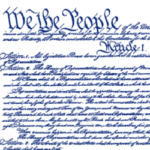With the Constitution, the Founding generation created the greatest charter of freedom in the history of the world. However, the Founding generation did not believe that it had a monopoly on constitutional wisdom. Therefore, the founders set out a formal amendment process that allowed later generations to revise our nation’s charter and “form a more perfect Union.” They wrote this process into Article V of the Constitution. Over time, the American people have used this amendment process to transform the Constitution by adding a Bill of Rights, abolishing slavery, promising freedom and equality, and extending the right to vote to women and African Americans. All told, we have ratified 27 constitutional amendments across American history. Learning objectives: Describe the reasons that the Founding generation included a formal process for amending the Constitution;
explain how the Constitution’s amendment process works, and why the founders made it so hard to amend the Constitution; identify the key periods of constitutional change in American history and outline factors that drive successful pushes to amend the Constitution; describe all 27 amendments to the U.S. Constitution.
The Bill of Rights
In this series of videos, students will hear from constitutional scholars such as Professor Tracey Meares of Yale University, Professor Orin Kerr of George Washington University, Dean Erwin Chemerinsky of Berkeley Law, and Michael McConnell, the director of the Stanford Constitutional Law Center. In these videos, two scholars discuss their interpretations of the amendments, often giving different points of view and interpretations.
The Bill of Rights in Modern Times
In this lesson, students will learn about the individual rights that are included in the Bill of Rights and current issues relating to them. Students will use C-SPAN Classroom’s Constitution Clips to explore what each of these rights mean and determine how these rights apply to current events in America. This lesson works well with classes with one-to-one devices or in flipped classrooms.
Constitution Clips
C-SPAN’s Constitution Clips makes the U.S. Constitution come alive by providing teachers and students with video clips from C-SPAN’s Video Library of the Constitution in action.
Constitution of the United States with Index and the Declaration of Independence, Pocket Edition

This is the 25th pocket edition of the complete text of two core documents of American democracy, the Constitution of the United States (with amendments) and the Declaration of Independence. The resolution calling for the ratification of Constitutional Convention is also included. A topical index to the Constitution is provided. (House Document 112-29, 2012)
Argument Wars (Game and Teacher Guide)
In Argument Wars, students will try out their persuasive abilities by arguing a real Supreme Court case. The other lawyer is their competition. Whoever uses the strongest arguments wins!
Colonial Influences (Lesson Plan and Powerpoint)
American colonists had some strong ideas about what they wanted in a government. These ideas surface in colonial documents, and eventually became a part of the founding documents like the Declaration of Independence and Constitution. But where did they come from? This lesson looks at the Magna Carta, Mayflower Compact, English Bill of Rights, Cato’s Letters and Common Sense.
Jury Selection: Edmonson v. Leesville Concrete Co.
Grade 6-8 The Bill of Rights & Me
The purpose of this lesson is to investigate the Bill of Rights through the perspective of someone living during the ratification period. After exploring the historical perspective of the Bill of Rights through study of the Dissent of the Minority in Pennsylvania, students will be asked to apply the rights they learned about to their lives today and assess, critique, and solve problems based on the modern meaning of these rights.
The Story of the Bill of Rights

This documentary tells the story of these individual freedoms that often are taken for granted today. But in 1787, when they were first discussed at the Constitutional Convention, the Founding Fathers rejected them. Why were these rights controversial then? The full story about these rights, including what they say and what they mean, is explained. Ten short videos examine each of the amendments in the Bill of Rights.
